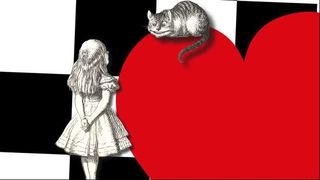Tonight we are celebrating the science and maths of Lewis Carroll in our Alice's Adventures in Numberland event with geek comedy trio Festival of the Spoken Nerd. As well as being a best-selling children’s author, Lewis Carroll was also a mathematics lecturer at Oxford University and an avid puzzler. He loved musing over word, number and logic problems and sharing them with his friends and colleagues. Special guest geek Katie Steckles has compiled this collection of Carroll-inspired brainteasers for your puzzling pleasure. How many can you complete? Answers can be found in this blog post.
DIFFICULTY LEVELS 
Easy 
Hard 

Fiendish 


MAZE 
Can you find a route from the outside of the maze to the centre?

A similar, but more complicated maze like this, created by Carroll in his early twenties, appeared in his family’s homemade puzzle magazine, Mischmasch.
DOUBLETS 

For each pair of words, can you find a series of words which link them, changing just one letter each time? All links must be real words. As an example, you can get from HEAD to TAIL using four links as follows:
HEAD
heal
teal
tell
tall
TAIL
Drive PIG into STY (4 links)
Make WHEAT into BREAD (6 links)
Raise FOUR to FIVE (6 links)
Prove GRASS to be GREEN (7 links)
Change OAT to RYE (3 links)
Cover EYE with LID (3 links)
Raise ONE to TWO (7 links)
Crown TIGER with ROSES (5 links)
Carroll introduced this type of puzzle, now more commonly known as a Word Ladder, in a letter to Vanity Fair in March 1879, and after initial trials, they began using it as their regular puzzle competition – the examples above are taken from there.
DOUBLE ACROSTIC POEM 


Each couplet in this poem clues an 8-letter word. If you find all 8 words, their first letters will spell out a word, and their last letters will spell out another word.
They’ll jump off a cliff from a great height, for fun 
In a computer game from 1991
Just the right tipple for a long run
To match your own chemical composition
Kids won’t touch it – they prefer jam
Sounds like it’s near Lewisham
Practise makes perfect, that’s what they say
Regarding the vehicle that takes you away
Brenda with three Es is feeling pretty
Confused about this northern city
Caesar’s troubled by its bite
Maybe a candlelit dinner tonight?
It’s almost like there’ll be bows and knots
At the time of year you give presents lots
The double acrostic is often thought of as the forerunner to the modern crossword puzzle, and Carroll made many contributions to the form. In his collection of poems Phantasmagoria (1869), he published an example in which the stanzas were more connected to form a readable poem, rather than disjointed as in the example above. Another, written by Carroll for Miss E M Argles, was printed in the catalogue for the exhibition in London to commemorate the centenary of Carroll’s birth.
AMBIGRAMS 
An ambigram is a word or phrase which is written in such a way that it reads the same when rotated, or reflected. Examples of different rotation and reflection ambigrams are given here. Can you devise a rotation ambigram for the word FISH? Or a reflection ambigram for BIRD? Or, you can try to devise one for your own name, or a word of your choice – some words are harder than others! You can use whichever type of letters you like, and add interesting serifs and decorations, as long as it still reads as that word. Sometimes ambigrams read as one word in one direction, and a different (sometimes opposite) word in the other.

OVERLAPPING SQUARES 
Can you draw this shape made from three interlaced squares, using one continuous line, without going over any parts of the line twice, without intersecting the line you’ve already drawn, and without taking your pen off the paper?

In Collingwood’s Life and Letters, Isabel Standen recalls being shown this puzzle by Carroll in 1869.
A DINNER PARTY 


At a dinner party, the host invites his father’s brother-in-law, his brother’s father-in-law, his father-in-law’s brother, and his brother-in-law’s father. What’s the smallest number of guests there could be?
This puzzle originally appeared in Lewis Carroll’s Eligible Apartments.
This puzzle originally appeared in Lewis Carroll’s Eligible Apartments.
With thanks to Katie Steckles (@stecks) for compiling these puzzles. Katie Steckles is a mathematician based in Manchester, who gives talks and workshops on maths. She finished her PhD in 2011, and since then has talked about maths in schools, at science festivals, on BBC radio, at music festivals, as part of theatre shows and on the internet. She enjoys doing and writing puzzles, solving the Rubik’s cube and baking things shaped like maths. (Ambigram credits: dreamworld: www.wowtattoos.com; mirror: www.otherfocus.com; fantasy: www.cogsci.indiana.edu; Coffee: www.elusiveillustration.com)
Stuart Smith (BBSRC intern, 2012)
Rachel Huddart (BBSRC intern, 2014)